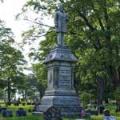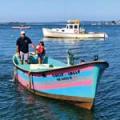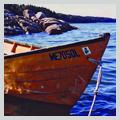Welcome Downeast
The Town, the Bays, the Mountains
 Illustration by Candice Hutchinson
Illustration by Candice Hutchinson
Looking out from the summit of a mountain on a May day, you see the familiar gray of winter, but that gray is now tinged with faint pastels of red, green, and yellow from burgeoning maples, aspens, and willows. Keep your eyes open for hawks and turkey vultures circling above, and don’t miss the speckled clouds of salamander eggs in vernal pools below. The eggs of the spotted salamander (Ambystoma maculatum) are protected by a cloud of jelly, either white or clear, attached to a twig or stem under the water, giving some protection from predators. When they hatch, they will live in the pool until it dries out and then they disappear into the soft, damp duff of the forest floor until the following spring when they return to their natal pool. The season of renewal is evident all around.
Natural wonders
Among the wonders of the Maine coast are falls where the tides flow through a narrow gut causing them to move much faster. Having seen Multnomah and Niagara I remember being disappointed the first time I visited the majestic Reversing Falls in Pembroke, thinking “Why do they call this the falls when it hardly falls at all?” But after an hour there, being captivated by the whole scene, disappointment was washed away by exhilaration and awe. The sound is mesmerizing, the beauty is transcendent and the wildlife drawn to the tidal action is abundant. Seals, ducks, cormorants, ospreys and eagles all fish there, and it all comes together to move the soul as few places can.
Historically, the First People were drawn to these places for similar reasons. Fishing artifacts dating back 5,000 years have been unearthed at the tidal falls in Blue Hill. Early European settlers harnessed the tides at these places to saw lumber and grind grain with water-powered mills. Today people come to these places for white-water kayaking, birding, sunning and picnicking, as well as spiritual nourishment.
Field report, May
It seems as though every living thing is preparing to take its place in the festival of fertility that will be the main event in the coming months—a pageant of passion that’s almost enough to make an old preacher blush, but not quite. Making their entrance this week are the dandelions, a great boon to pollinators like our native bumblebees and digger bees. Like so many other things these days, dandelions seem to be surprisingly polarizing. People love ‘em or hate ‘em, and if you hate them and the wind is carrying their seeds far and wide, and onto your lawn, what can you do? One idea is to make dandelion wine!
Winnie’s dandelion wine recipe
3 quarts dandelion blossoms
4 quarts boiling water
3 lbs. sugar
2 medium oranges, 2 lemons
1 package yeast
A handful of raisins
Put the blossoms in a crock, and pour in the boiling water. Let stand for three days, stirring each day. Strain water and blossoms into an enamel pot with sugar etc. Simmer for an hour, add raisins. Cover and cool, then add yeast. Cork lightly for six months.
Saltwater report
On a different kind of excursion, I once set out in my handmade kayak to paddle to one of the islands in the bay. This kayak had a new skeg attached with a long piece of copper wire to keep it on a straight course in a breeze. Soon there was a faint humming sound coming from the skeg, apparently caused by the wire vibrating. The faster the kayak moved the louder the hum. Soon after that several dark shapes appeared swimming along near the bow as though escorting my little craft to its destination. These were harbor porpoises, shy and elusive cousins of the familiar bottle-nosed dolphins. They live and play in bays and estuaries all up and down the Maine coast. We traveled through gentle swells for some time together, and I imagined them smiling as much as I was. I never saw them again.
Forest report
When we think of flowering trees we generally think of deciduous trees like apple, cherry, shad, and the like, lovely white to pink blossoms with five petals. But much of the pollen we’ve been seeing and sneezing these days is coming from white pine flowers. This magnificent tree is the emblem of the state of Maine, gracing our old state flag along with the moose, the lumberman and the sailor. These pine flowers resemble tiny pineapples or ears of corn or pussy willows depending on what source you consult. Best go out and see the Maine state flower for yourself.
Structural appreciation
If your house was built before the Civil War and you live in Maine, it is likely to feature post-and-beam construction—a hand-hewn frame covered with sawn boards. Your commentator is no expert on this matter, but we have learned a few things by living in four of these structures. These buildings were built to last, and last they do. Years ago we watched with dismay the demolition of one of the oldest houses in town to make room for a mini-mart. They brought in a bulldozer to flatten the old post-and-beam structure, but the machine could not do it, until they went in with chainsaws and cut the frame apart. One of the beauties of this style of construction is that the frame can stand by itself. Not so with later “stick-built” construction which depends on its sheathing to give it strength. Because they are pegged together, these structures can be taken apart and moved or repurposed. They are models of engineering and construction predating internal combustion engines or hydraulics. Many families built their own houses, and anyone who could build a large barn or a schoolhouse or a meetinghouse was a highly valued member of the community.
Imagine for a moment the complexities involved in raising a steeple on one of the hundreds of meetinghouses in Maine with no machinery beyond lever and block-and-tackle, and no source of power beyond manpower or oxen power, and using all locally-sourced, recyclable, biodegradable materials.
One time while the remnants of a hurricane roared up the coast, I went to check on the church building. Windows rattled and I could feel the bell-rope move in my hand. I climbed into the steeple and could feel it move under my feet, its beams and trusses groaning, as it rode out yet another storm of the many it had endured. The more we know about our forebears, the greater our respect.
Natural events, June
June is upon us, offering her perfect blue and green days with one foot in spring and the other in summer. Our challenge now is to not let them slip by but to hold each one and savor it deeply. One day it is hot and dry, the next it is cool and misty. One day it is overcast, the next day great towering cumulus clouds float by against a bright blue field like the armada of some heavenly emperor. New leaves are still appearing on some trees while others are going to seed.
To get out and soak up all that splendor, without being overtaken by buzzing insects of spring, you may need some bug-dope. Bug-dope is anything that will repel mosquitoes and black flies, and has long been a Maine cottage industry, sort of like yard sales, maple syrup, and selling camp wood by the road. In the logging camps, we are told, they used to smear on lard or bacon grease or pine tar and call it good. After a few weeks without a bath that would build up into a leathery armor that bugs couldn’t breach. Home recipes might include camphor or eucalyptus and some proprietary “secret ingredients.” Generally these recipes didn’t work much better than the bear grease, but it gives the comforting illusion that we were doing something about those nasty bugs. In the end the comfort comes mostly from knowing that the bugs are feeding the birds, as well as keeping all the softies off the hiking trails and out of the woods for a while.
Avian report
During a rainstorm this week we heard a robin singing ecstatically, cascades of trilling tunes, like a soprano after a glass of champagne, only better. We watch the robins reveling in the birdbath, concluding that they are Baptists, not Congregationalists, dunkers, not sprinklers; they get right into it, washing their sparse sins away. Two song sparrows kiss on the rim of the birdbath.
Field and forest report
For pure contentment nothing does better than a sunny field of satiny grasses dotted with buttercups, sweet clover and daisies all swaying in the breeze. Sweet splendor in the grass. Our ancestors valued such fields to feed their livestock which in turn fed them and kept them strong. No wonder the sight of a rich field fills us with such contentment. Meanwhile, not far away the lady’s slipper, star flower, trillium and bunchberry are in bloom in the woods. Bunchberry is our Northern dogwood. Its leaves and cruciform ivory blossoms are just like dogwood farther South, but instead of a tree, ours is a low ground cover. We’re told that white-tailed deer love the bright red berries.
Things are moving so fast as the parade of summer passes that it’s hard for your reporter to keep up. You’ll notice that the yellow hawkweed is giving way to the orange hawkweed or ‘Devil’s paintbrush’ while buttercups are giving way to daisies. The lupine goes by while the hauntingly beautiful wild iris or ‘blue flag’ unfurls in damp sunny places. Seeds are forming on the ashes and lindens, while oval cones with designs like ancient Pueblo pottery form on conifers. Pink-tinted flower clusters form on Valerian and petals fall from the lupine-like black locust.
We stand like spectators entranced by the most magnificent procession of all as the flora and fauna of the season day after day troop in succession before us: brilliant, beautiful, grim, gaudy, grand, aglow and holy.
Rank opinion
Our goal here at the Almanack has always been to help others feel more at home in Nature. This stems from our conviction that knowledge and love of other living things will do more to save the earth than will shame or guilt or outrage or fear. Some of our greatest sources of hope are the young who come into this world with an instinctive compassion for other creatures. If we have changed anyone’s “Ugh” and “Eeww” to “Oooh” or “Wow” in the great outdoors, if we have helped anyone along the path from being a consumer to a caretaker, to that extent we have achieved our goal.
Seedpod to carry around
From Anais Nin: “And the day came when the risk to remain tight in a bud was more painful than the risk it took to blossom.”
That’s the Almanack for this time. But don’t take it from us—we’re no experts. Go out and see for yourself.
Yr. mst. humble & obd’nt servant,
Rob McCall.
✮
Rob McCall lives in Brooklin, Maine. This almanack is excerpted from his radio show on WERU FM, which can be streamed on weru.org.
Related Articles
Share this article:
2023 Maine Boat & Home Show

Join Us for the Maine Boat & Home Show!
Art, Artisans, Food, Fun & Boats, Boats, Boats
August 11 - 13, 2023 | On the waterfront, Rockland, Maine
Click here to pre-order your tickets.
Show is produced by Maine Boats, Homes & Harbors magazine.















